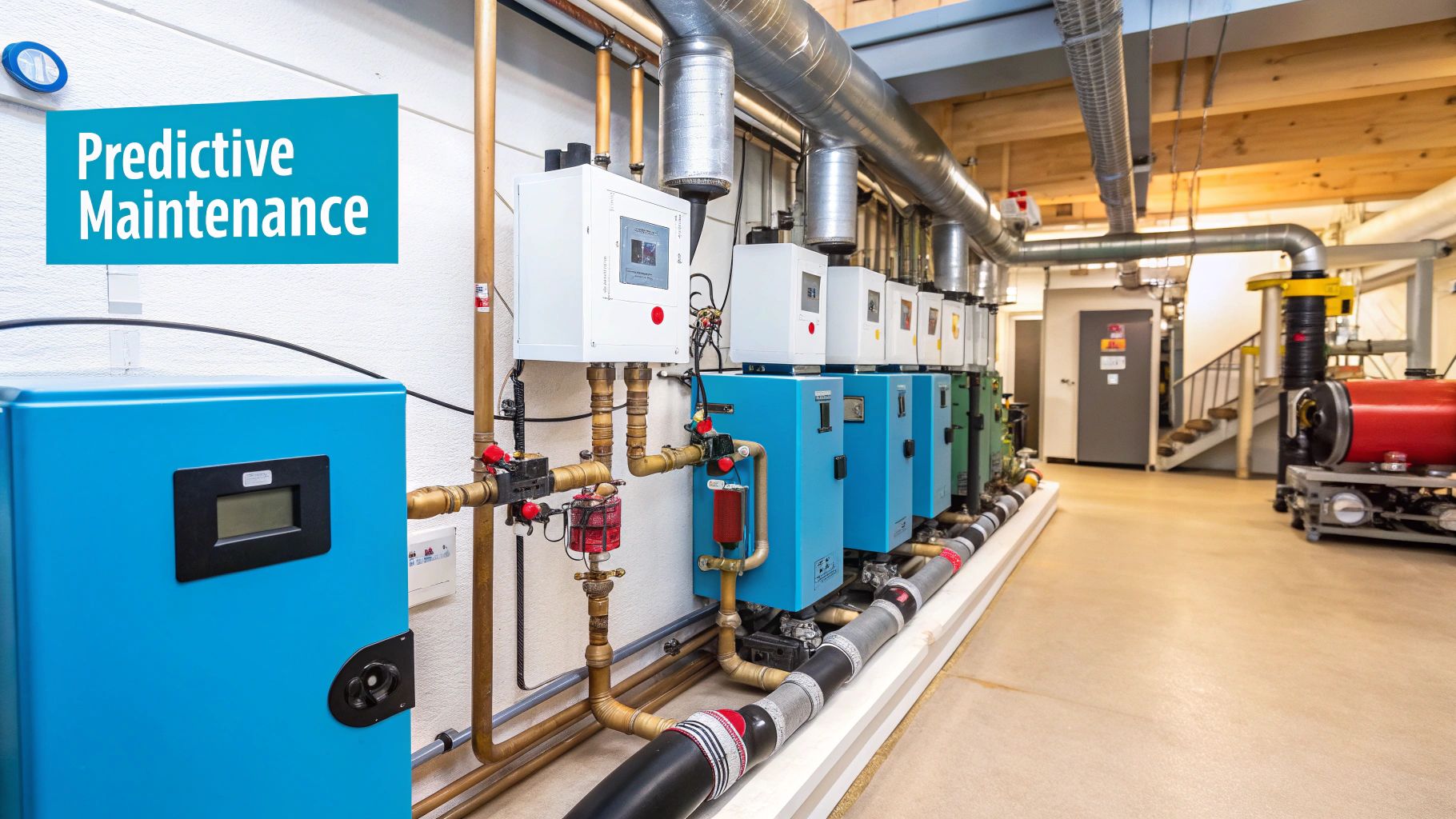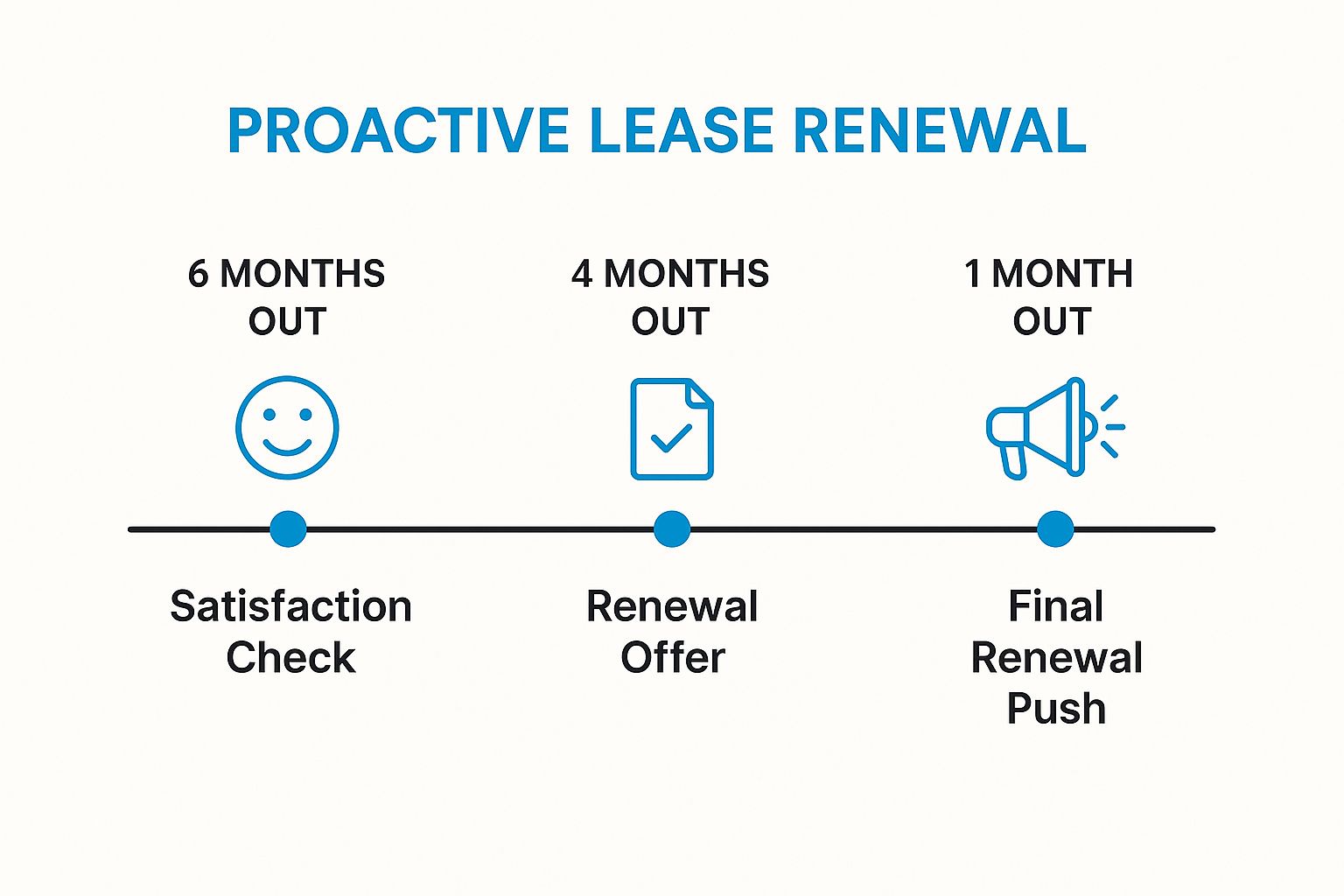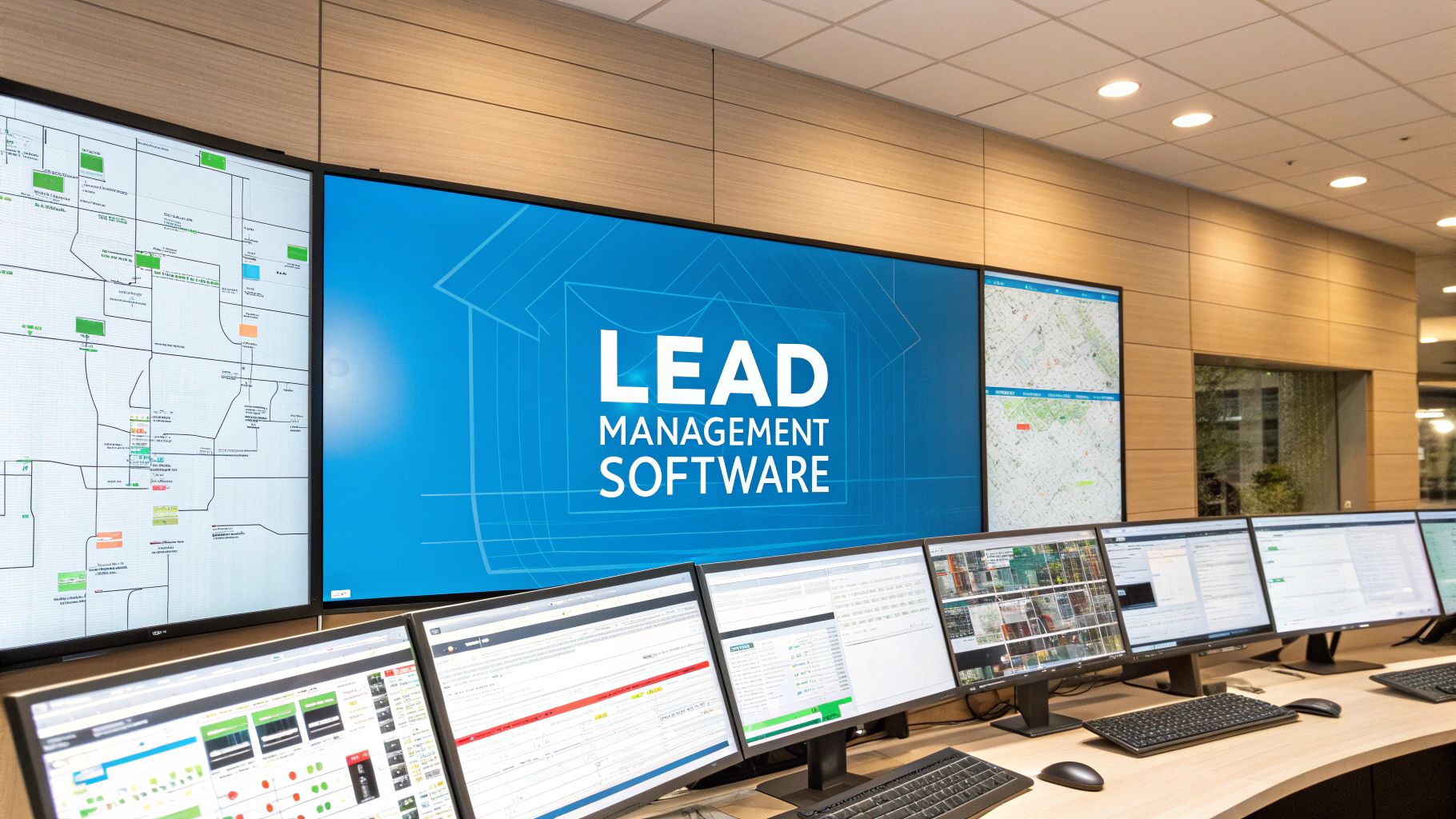Keeping Your Residents Happy: A Guide to Effective Tenant Retention
High tenant turnover is a costly problem. Vacancies drain your revenue, marketing burns through your budget, and the administrative workload never ends. Effective tenant retention strategies are crucial for maximizing your profitability and building a stable rental business. This detailed guide provides seven powerful strategies to keep your residents happy and renewing their leases.
This isn't just a collection of generic tips. We'll delve into specific, actionable tactics you can implement immediately to see real results. We'll explore methods for optimizing communication, leveraging technology, and fostering a sense of community within your property. You will learn how to:
- Proactively address maintenance issues before they become major problems
- Personalize resident interactions to build stronger relationships
- Create flexible lease options to accommodate individual needs
- Offer value-added services that enhance residents' lifestyles
- Integrate technology to streamline operations and improve the tenant experience
These tenant retention strategies provide a solid foundation for boosting your bottom line. By focusing on resident satisfaction and proactively addressing their needs, you can cultivate a thriving rental community and minimize costly turnover. Let's dive in.
1. Predictive Maintenance and Proactive Repairs
Tired of reacting to tenant maintenance emergencies? Predictive maintenance and proactive repairs offer a revolutionary approach to property management, shifting from reactive fixes to preventative measures. This strategy leverages data analytics, IoT sensors, and regular inspections to identify and address potential maintenance issues before they escalate into costly problems and tenant complaints. Imagine addressing a leaky pipe before it causes water damage, or servicing an HVAC system before it fails in the middle of summer. This proactive approach minimizes unit downtime, reduces repair expenses, and fosters positive tenant relationships.

Real-World Success Stories
Several leading property management companies have already embraced predictive maintenance, demonstrating its potential for significant ROI and improved tenant satisfaction.
- Greystar Real Estate Partners: Utilizing IoT sensors to monitor HVAC performance across their portfolio, Greystar has reported a 35% reduction in maintenance costs.
- Related Companies: Implementing predictive maintenance in their luxury properties, Related Companies has achieved a 95% tenant satisfaction rate with their maintenance response.
- Camden Property Trust: This company uses smart home technology to anticipate and prevent common maintenance problems, often before tenants even notice an issue.
Practical Implementation Tips
Transitioning to a predictive maintenance model requires a strategic approach. Here are some actionable steps to get you started:
- Prioritize High-Impact Systems: Begin by focusing on systems with the greatest potential for disruption and expense, such as HVAC units, plumbing, and water heaters.
- Invest in Training: Equip your maintenance staff with the skills to use new technologies and provide excellent customer service. A proactive approach also requires strong communication skills to effectively schedule and explain preventative maintenance to tenants.
- Automate Tenant Notifications: Implement a system for automatically notifying tenants about scheduled maintenance visits. This fosters transparency and minimizes disruption to their routines.
- Continuous Improvement: Regularly analyze data and tenant feedback to refine your prediction algorithms and maintenance schedules for optimal efficiency.
- Establish Clear Response Timeframes: Define specific response times for different types of maintenance issues, ensuring both urgent and non-urgent requests are handled promptly and professionally.
Benefits of Predictive Maintenance
This strategy is more than just fixing things before they break; it’s about cultivating a proactive and tenant-centric approach to property management. This approach leads to:
- Reduced Costs: Fewer emergency repairs translate to lower overall maintenance expenses.
- Increased Tenant Satisfaction: Proactive maintenance minimizes disruptions and demonstrates a commitment to tenant well-being, fostering long-term tenancy.
- Improved Property Value: Well-maintained properties attract and retain higher quality tenants, contributing to increased property value.
- Enhanced Operational Efficiency: Predictive maintenance allows for better planning and resource allocation, streamlining maintenance operations.
Prioritizing tenant maintenance requests is a crucial aspect of predictive maintenance, and you can learn more about this important topic. Implementing predictive maintenance and proactive repairs is a key tenant retention strategy for single-family property managers, property management companies, and large rental portfolio owners alike, significantly impacting tenant satisfaction and your bottom line. By embracing this forward-thinking approach, you can position yourself as a leader in providing a superior tenant experience, ultimately maximizing your property’s potential.
2. Personalized Communication and Relationship Building
Tired of treating tenants like numbers on a spreadsheet? Personalized communication and relationship building offers a refreshing approach to tenant retention, focusing on creating genuine connections with each individual. This strategy recognizes that tenants are not just lease agreements; they are people who value being seen, heard, and understood. It involves tailoring communication, recognizing milestones, and offering customized service approaches to foster a sense of community and loyalty. Imagine remembering a tenant's birthday or offering personalized move-in support based on their specific needs. This personal touch can significantly impact tenant satisfaction and long-term tenancy.

Real-World Success Stories
Several companies have successfully implemented personalized communication, showcasing its effectiveness in boosting tenant retention.
- Avalon Communities: Sends personalized birthday cards and anniversary gifts, boasting an 85% renewal rate.
- Equity Residential: Uses tenant surveys to customize amenity offerings, resulting in a 12% increase in tenant satisfaction scores.
- BuzzBuzzHome: Creates individualized move-in experiences tailored to tenant lifestyle preferences.
Practical Implementation Tips
Building personalized tenant relationships requires a thoughtful approach. Here are some actionable steps to implement this strategy:
- Use Move-In Surveys: Gather tenant preferences and preferred contact methods.
- Implement a Tenant CRM System: Track interactions, preferences, and important dates.
- Train Staff: Equip your team with active listening and relationship-building skills.
- Create Customizable Templates: Develop standardized yet adaptable communication templates.
- Set Automated Reminders: Automate reminders for important tenant dates and milestones.
Benefits of Personalized Communication
This strategy goes beyond simple pleasantries; it's about building a strong tenant community. This approach leads to:
- Increased Renewals: Tenants who feel valued and understood are more likely to renew their leases.
- Stronger Tenant Relationships: Personalized communication fosters a sense of trust and connection.
- Positive Word-of-Mouth Referrals: Happy tenants become advocates for your property.
- Improved Online Reputation: Positive tenant experiences translate to better online reviews.
Learn more about Personalized Communication and Relationship Building. Implementing personalized communication is a powerful tenant retention strategy for property managers of all scales. By prioritizing individual connections, you cultivate tenant loyalty, improve your reputation, and ultimately maximize your property’s potential. This approach distinguishes you from competitors, demonstrating a genuine commitment to tenant well-being and fostering long-term tenant relationships.
3. Flexible Lease Terms and Rent Optimization
Tired of fixed lease terms and predictable vacancy cycles? Flexible lease terms and rent optimization offer a dynamic approach to lease agreements, providing tenants with various options while maximizing your revenue potential. This strategy caters to the evolving needs of today's renters, offering choices in lease duration, payment structures, and other rental terms. By aligning these options with real-time market data, you can optimize pricing strategies for maximum occupancy and profitability. Imagine offering short-term leases during the off-season or customized lease lengths to attract and retain high-quality tenants. This flexible approach empowers tenants while enhancing your financial performance.
Real-World Success Stories
Several innovative property management companies have adopted flexible lease terms and rent optimization, demonstrating its effectiveness in attracting and retaining tenants.
- Common (co-living company): Offering flexible lease terms starting at one month, Common has achieved impressive 95% occupancy rates, catering to the needs of mobile professionals and short-term renters.
- Greystar Real Estate Partners: Implementing seasonal pricing adjustments based on market demand, Greystar has reported revenue increases of 8-15% annually. This dynamic pricing strategy maximizes revenue during peak seasons while remaining competitive during slower periods.
- UDR: This company leverages predictive analytics to offer personalized renewal terms to existing tenants, resulting in an 18% improvement in tenant retention rates. By understanding individual tenant needs, UDR can tailor lease agreements to encourage long-term tenancy.
Practical Implementation Tips
Integrating flexible lease terms and rent optimization requires a strategic and data-driven approach. Here are some actionable steps:
- Use Revenue Management Software: Invest in revenue management software to analyze market trends, competitor pricing, and occupancy data. This data-driven approach ensures optimal pricing strategies for different lease term options.
- Offer Early Renewal Discounts: Incentivize long-term tenancy by offering attractive renewal discounts 90-120 days before lease expiration. This proactive approach encourages tenants to renew, reducing vacancy periods.
- Create Clear Pricing Tiers: Develop transparent pricing tiers for different lease term options, clearly outlining the benefits and costs associated with each choice. This empowers tenants to select the lease structure that best suits their needs and budget.
- Monitor Market Conditions: Regularly track local market conditions and competitor pricing to ensure your rental rates remain competitive while maximizing your revenue potential. Stay agile and adjust pricing as needed to respond to market fluctuations.
- Communicate Value: Clearly articulate the value proposition of different lease options to potential tenants. Highlight the benefits of flexibility and how it can cater to their specific lifestyle and financial circumstances.
Benefits of Flexible Lease Terms and Rent Optimization
This strategy is not just about offering choices; it's about creating a win-win scenario for both tenants and property owners. This approach leads to:
- Increased Occupancy Rates: Flexible lease terms attract a wider range of tenants, including those seeking short-term options, leading to higher occupancy levels.
- Improved Tenant Retention: Personalized lease agreements and renewal incentives encourage tenants to stay longer, reducing turnover and vacancy costs.
- Optimized Revenue: Dynamic pricing strategies based on market data ensure you’re capturing the maximum potential rent for each unit.
- Enhanced Tenant Satisfaction: Offering choices empowers tenants and demonstrates a commitment to meeting their individual needs, fostering positive tenant relationships.
Flexible lease terms and rent optimization are a valuable tenant retention strategy for single-family property managers, property management companies, and large rental portfolio owners. By embracing this adaptable approach, you can attract a wider tenant pool, optimize your revenue streams, and foster long-term tenant relationships, ultimately maximizing your property’s potential.
4. Community Building and Social Programming
Tired of high tenant turnover? Community building and social programming offers a powerful tenant retention strategy, transforming rental properties from simply places to live into vibrant communities where residents feel connected and want to stay. This approach focuses on fostering a sense of belonging among tenants through organized events, shared spaces, social platforms, and resident engagement programs. Imagine a property where neighbors know each other, socialize regularly, and feel a genuine connection to their living environment. This sense of community encourages long-term tenancy and reduces costly turnover.

Real-World Success Stories
Several properties have successfully implemented community-building initiatives, demonstrating the positive impact on tenant retention.
- The Deco Apartments (Washington D.C.): By hosting monthly wine tastings and fitness classes, The Deco has achieved impressive 92% renewal rates.
- Via6 (Seattle): This property established resident committees that organize events, leading to 40% higher tenant satisfaction scores.
- Avalon Communities: Through partnerships with local businesses, Avalon offers exclusive discounts and experiences for their tenants, enhancing resident satisfaction and loyalty.
Practical Implementation Tips
Building a strong community requires a thoughtful approach. Here are some practical tips to get started:
- Tenant Surveys: Conduct surveys to understand tenant interests and preferences for event types.
- Start Small: Begin with low-cost, high-impact events like coffee hours or movie nights.
- Virtual and In-Person Options: Offer a mix of virtual and in-person events to cater to different preferences.
- Strategic Common Areas: Design and utilize common areas to encourage natural social interaction.
- Local Partnerships: Collaborate with local businesses to reduce event costs and provide added value for tenants.
Benefits of Community Building
This strategy goes beyond simply organizing events; it cultivates a sense of belonging and shared experience. Key benefits include:
- Increased Tenant Retention: A strong community encourages tenants to renew their leases, reducing turnover costs.
- Enhanced Tenant Satisfaction: Residents feel more valued and connected, leading to higher satisfaction scores.
- Positive Word-of-Mouth Referrals: Happy tenants are more likely to recommend your property to others.
- Improved Property Reputation: A thriving community enhances your property's reputation and attracts high-quality tenants.
Community building and social programming is a valuable tenant retention strategy for property managers of all sizes. By fostering a sense of belonging among residents, you create a desirable living environment that encourages long-term tenancy and contributes to a positive bottom line. This proactive approach differentiates your property and establishes a loyal tenant base, maximizing your investment and fostering a thriving community.
5. Technology Integration and Smart Home Features
Today's renters expect more than just four walls and a roof. They desire convenience, security, and a modern living experience. Technology integration and smart home features offer a powerful way to meet these evolving expectations and boost tenant retention. This strategy involves implementing smart home technology, mobile apps, and digital services to enhance the tenant experience. Imagine keyless entry, smart thermostats, and online rent payment – all contributing to a seamless and attractive living environment.
Real-World Success Stories
Several property management companies have successfully leveraged technology to elevate their tenant experience and improve retention rates.
- Related Companies: Integrating Nest thermostats and smart locks across their portfolio, Related Companies has reported a 20% reduction in energy costs, a benefit they can pass on to tenants or reinvest in property upgrades.
- Camden Property Trust: Their mobile app handles 75% of tenant service requests, improving response times by 50% and streamlining communication.
- Equity Residential: Smart apartment features, like integrated lighting and automated window shades, command 10-15% rent premiums over traditional units, demonstrating tenant willingness to pay for enhanced convenience.
Practical Implementation Tips
Integrating technology effectively requires a strategic approach. Here are some actionable steps:
- Start Small, Scale Up: Begin with basic smart features like smart locks or thermostats and expand based on tenant feedback and budget.
- Choose Reliable Partners: Select technology partners with strong support and integration capabilities to ensure seamless operation and minimal technical issues.
- Educate Your Tenants: Provide comprehensive tenant education on how to use smart home features, maximizing their benefits and minimizing frustration.
- Prioritize Security: Ensure robust cybersecurity measures for all connected devices to protect tenant data and privacy.
- Have a Backup Plan: Create backup systems for when technology fails, such as physical keys for smart locks, ensuring tenants aren’t locked out during outages.
Benefits of Technology Integration
Technology integration is about creating a modern, efficient, and desirable living experience. This leads to:
- Increased Convenience: Features like online rent payment and smart home controls simplify daily life for tenants.
- Enhanced Security: Smart locks and security systems provide added peace of mind.
- Improved Communication: Mobile apps and online portals streamline communication between tenants and property managers.
- Cost Savings: Smart thermostats and energy-efficient appliances can reduce utility costs.
- Competitive Advantage: Tech-enabled properties attract and retain tech-savvy tenants, giving you an edge in a competitive market.
Implementing technology integration and smart home features is a key tenant retention strategy. By embracing technology, you can create a more appealing and convenient living environment, ultimately attracting and retaining high-quality tenants and maximizing your property’s potential. This approach appeals to modern renters seeking a streamlined and connected living experience, directly contributing to higher tenant satisfaction and longer lease terms.
6. Value-Added Services and Lifestyle Amenities
Today's renters seek more than just four walls and a roof. They desire a comprehensive living experience. Value-added services and lifestyle amenities elevate your property from simple accommodation to a lifestyle solution. This tenant retention strategy focuses on providing services that enhance tenants' daily lives, fostering a sense of community and convenience. Think concierge services, fitness programs, co-working spaces, package delivery management, and even pet-friendly amenities. This approach positions your property as a desirable and convenient place to live, encouraging long-term tenancy.
Real-World Success Stories
Several property management companies have successfully integrated value-added services, demonstrating their effectiveness in boosting tenant satisfaction and retention.
- Avalon Communities: Offering services like dry cleaning pickup, dog walking, and grocery delivery, Avalon Communities has reported an 88% tenant satisfaction rate. These convenient services cater to busy lifestyles and contribute to a positive tenant experience.
- The Hudson Companies: Providing on-site co-working spaces not only caters to the growing work-from-home trend but also generates additional revenue streams and fosters a sense of community among tenants, increasing tenant loyalty.
- Related Companies: This company’s concierge services handle a wide range of tasks, from restaurant reservations to home repairs, providing a premium living experience that sets them apart. This high level of service fosters tenant loyalty and justifies premium rental rates.
Practical Implementation Tips
Implementing value-added services requires careful planning and execution. Consider these practical tips:
- Tenant Surveys: Conduct regular surveys to identify the most desired services and amenities. This ensures you're investing in offerings that truly resonate with your tenants.
- Local Partnerships: Partner with local service providers to streamline operations and reduce your management burden. This allows you to offer a wider range of services without significant overhead.
- Competitive Pricing: Price your services competitively compared to external alternatives. Tenants should perceive value in using your on-site services.
- Start Small: Begin with high-demand, low-maintenance services and gradually expand your offerings based on tenant feedback and market trends. This minimizes initial investment and allows for iterative improvement.
- Service Packages: Create tiered service packages that appeal to different tenant segments and budgets. This allows tenants to customize their experience and choose the services that best fit their needs.
Benefits of Value-Added Services
Implementing value-added services offers numerous benefits for both tenants and property managers, contributing significantly to tenant retention strategies. These benefits include:
- Enhanced Tenant Satisfaction: Convenient services simplify tenants' lives, contributing to a positive living experience and increased satisfaction.
- Competitive Advantage: Value-added services differentiate your property from competitors, attracting and retaining high-quality tenants.
- Increased Property Value: Desirable amenities and services enhance the perceived value of your property, potentially justifying higher rental rates.
- Stronger Community: Shared amenities and services foster a sense of community among tenants, creating a more engaging and desirable living environment.
Value-added services are a powerful tenant retention strategy, transforming your property from simply a place to live into a vibrant and convenient community. By understanding tenant needs and implementing services that enhance their lifestyle, you can cultivate long-term tenant relationships and maximize your property’s potential.
7. Proactive Lease Renewal Programs
Tired of last-minute lease negotiations and unexpected vacancies? Proactive lease renewal programs offer a systematic approach to tenant retention, treating renewal as an ongoing process rather than a one-time event. This strategy begins early in the lease term and involves structured outreach, incentive programs, market analysis, and personalized renewal offers. Imagine securing a lease renewal six months before the current lease expires, eliminating the uncertainty and stress associated with tenant turnover. This proactive approach fosters stronger tenant relationships, reduces vacancy periods, and stabilizes your rental income.

The infographic above visualizes the key stages of a proactive lease renewal program, highlighting the importance of early and consistent communication with tenants. By initiating contact well in advance of the lease expiration, property managers can gauge tenant satisfaction, address any concerns, and present attractive renewal options.
Real-World Success Stories
Several property management companies have implemented proactive lease renewal programs with impressive results:
- Greystar Real Estate Partners: By initiating renewal conversations 120 days in advance, Greystar achieves a 75% renewal rate.
- UDR: Utilizing predictive analytics to identify at-risk tenants, UDR achieves 80% retention through targeted interventions.
- Camden Property Trust: Their tiered renewal incentive program has increased retention by 22% year-over-year.
Practical Implementation Tips
Building a successful proactive lease renewal program requires a structured approach. Here are some actionable steps:
- Create a Renewal Timeline: Establish a timeline with specific touchpoints, such as satisfaction checks at six months, renewal offers at four months, and final follow-ups one month before lease expiration.
- Personalize Offers: Leverage tenant data to customize renewal offers and incentives. Consider offering longer lease terms, waived fees, or property upgrades.
- Train Your Staff: Equip your team with the skills to handle renewal conversations effectively and address tenant concerns.
- Offer Multiple Options: Provide tenants with a variety of renewal options, catering to different needs and preferences.
- Track and Optimize: Monitor key renewal metrics, such as renewal rates, and continuously refine your process.
Benefits of Proactive Lease Renewal Programs
This strategy goes beyond simply renewing leases; it builds stronger tenant relationships and optimizes your property's performance. The benefits include:
- Increased Retention Rates: Early engagement and personalized offers encourage tenants to renew.
- Reduced Vacancy Costs: Minimizing turnover reduces vacancy periods and associated expenses.
- Improved Tenant Satisfaction: Proactive communication demonstrates a commitment to tenant well-being.
- Stable Rental Income: Consistent renewals contribute to predictable cash flow.
Learn more about Proactive Lease Renewal Programs and discover effective strategies to retain your valued tenants. Implementing proactive lease renewal programs is a key tenant retention strategy for single-family property managers, property management companies, and large rental portfolio owners, significantly impacting tenant satisfaction and your bottom line. By embracing this proactive approach, you can cultivate long-term tenant relationships and maximize your property's potential.
7 Key Tenant Retention Strategies Comparison
The Future of Tenant Retention: Building Lasting Relationships
In the competitive rental market, tenant retention strategies are no longer a luxury, but a necessity. This article explored seven key strategies for reducing vacancy rates and building a thriving rental community: predictive maintenance, personalized communication, flexible lease terms, community building, technology integration, value-added services, and proactive lease renewals. Each of these tactics, when implemented effectively, contributes to a positive resident experience that encourages long-term tenancy.
The Value of Long-Term Tenants
Retaining tenants offers significant financial benefits. It reduces turnover costs associated with marketing, cleaning, and preparing units for new residents. Long-term tenants also provide a stable income stream and contribute to a sense of community within the property. Furthermore, satisfied residents are more likely to refer new tenants, acting as organic advocates for your properties.
Key Takeaways for Effective Tenant Retention
Mastering tenant retention requires a shift from reactive problem-solving to proactive relationship building. This means anticipating tenant needs, fostering open communication, and creating a living environment that residents truly value. Remember these key takeaways:
- Prioritize preventative maintenance: Addressing issues before they escalate demonstrates care and prevents costly repairs down the line.
- Personalize the tenant experience: Tailor communication and services to individual needs and preferences.
- Embrace technology: Leverage technology to streamline communication, manage maintenance requests, and offer modern conveniences.
- Foster a sense of community: Create opportunities for residents to connect and build relationships.
Implementing Your Tenant Retention Plan
Start by evaluating your current tenant retention efforts. Identify areas for improvement and prioritize the strategies that align with your property type and target demographic. Consistent implementation and ongoing evaluation are crucial for long-term success. Track key metrics such as renewal rates, resident satisfaction scores, and maintenance request resolution times to measure the effectiveness of your strategies. Adapting your approach based on data and feedback will ensure your efforts remain relevant and impactful.
The future of tenant retention hinges on building genuine, lasting relationships with residents. By fostering a sense of community and providing exceptional service, property managers can create a living experience that residents are reluctant to leave. This not only benefits your bottom line but also contributes to a thriving and vibrant rental community.
Looking for tools to streamline your tenant management and enhance communication? Showdigs offers a comprehensive platform for scheduling showings, managing tenant interactions, and optimizing your leasing process, all of which contribute to improved tenant satisfaction and retention. Visit Showdigs to learn more.







